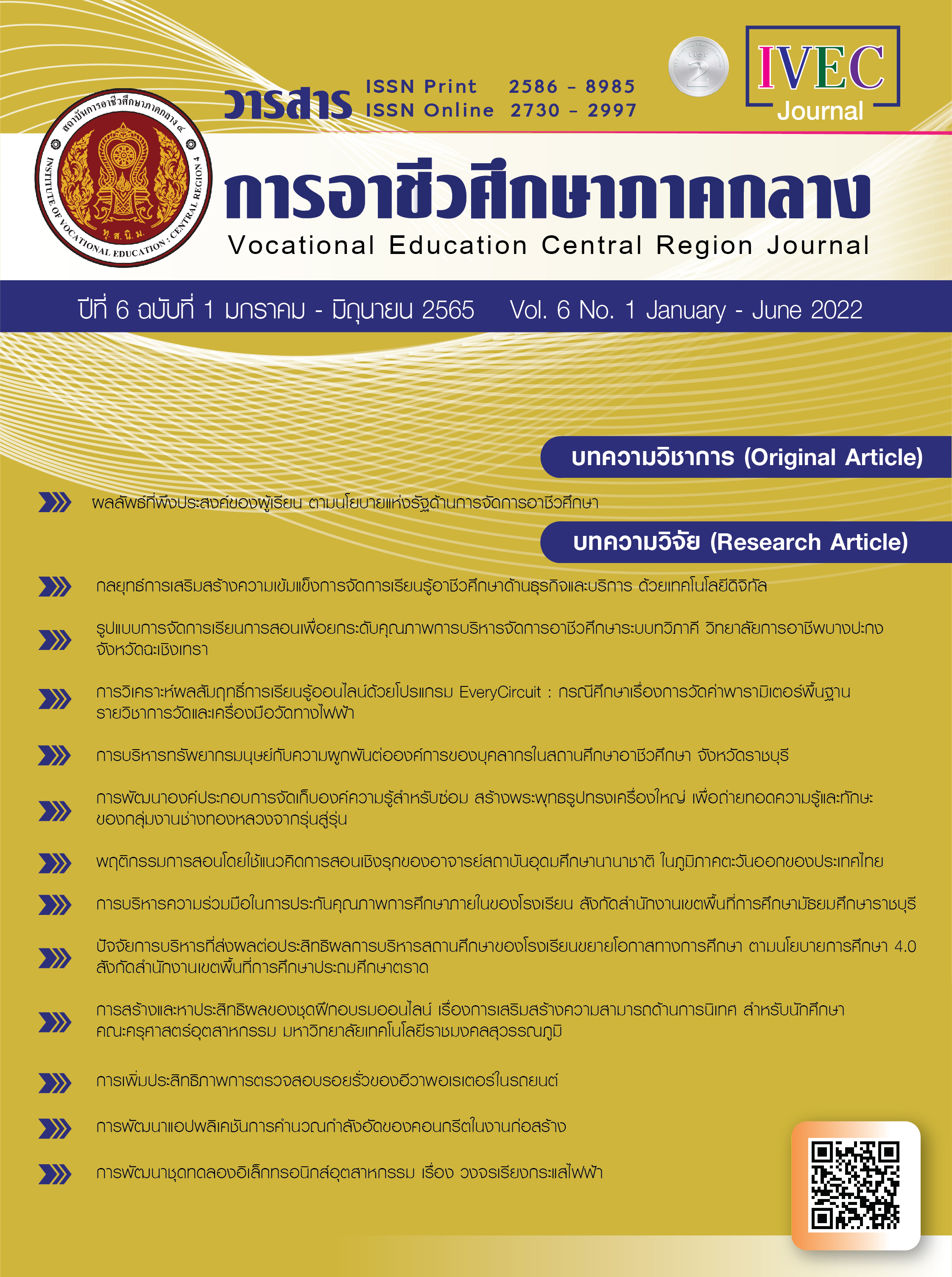The Strategies for Strengthening Vocational Learning Management in Business and Services using Digital Technology
Main Article Content
Abstract
The general purpose of this research was to develop the strategies for strengthening vocational learning management in business and services using digital technology. There were 5 phases of research methodology. A study current conditions, problems, and factors for strengthening vocational learning management in business and services using digital technology, A develop the strategies, A try out the strategies, A assess the use of the strategies, A provide a policy recommendation. The instruments were consisted of recording form, interview form, group conversation recording form, assessment form and questionnaire. by calculating the mean standard deviation and content analysis. The findings of developing the strategies for strengthening vocational learning management in business and services using digital technology showed the components of vision, mission, objectives, and goals. There were 4 main strategies with 16 indicators, 11 strategies, and 13 projects. Correlation and relationship0were0found0significant.
Article Details

This work is licensed under a Creative Commons Attribution-NonCommercial-NoDerivatives 4.0 International License.
|
บทความ ข้อมูล เนื้อหา รูปภาพ ฯลฯ ที่ได้รับการตีพิมพ์ในวารสาร การอาชีวศึกษาภาคกลาง ถือเป็นลิขสิทธิ์ของวารสารการอาชีวศึกษาภาคกลางหากบุคคลหรือหน่วยงานใดต้องการนำทั้งหมดหรือส่วนใดส่วนหนึ่ง ไปเผยแพร่ต่อหรือเพื่อกระทำการใด ๆ กองบรรณาธิการไม่สงวนสิทธิ์ ในการคัดลอกบทความเพื่อการศึกษาแต่ให้อ้างอิงแหล่งที่มาให้ครบถ้วน สมบูรณ์ สงวนสิทธิ์ โดย สถาบันการอาชีวศึกษาภาคกลาง 4 ที่ตั้ง 90 ถนนเทศา ตำบลพระปฐมเจดีย์ อำเภอเมือง จังหวัดนครปฐม โทรศัพท์ 034 242 856 , โทรสาร 034 242 858 ISSN : 3056-9176 (print) ISSN : 2985-2382 (online) |
References
กิตติศักดิ์ โสตาภา. (2558). สภาพปัญหาและความต้องการการใช้เทคโนโลยีสารสนเทศในการบริหารสถานศึกษาในจังหวัดนครพนม. วิทยานิพนธ์ ปริญญาครุศาสตรมหาบัณฑิต มหาวิทยาลัยนครพนม
ฐิตา เภกานนท์. (2563). ภาคบริการไทย เปลี่ยนให้ปัง! ปรับให้โดน. ค้นเมื่อ พฤศจิกายน 15, 2564, จาก https://www.bot.or.th/Thai/MonetaryPolicy/ArticleAndResearch/Pages/FAQ167.aspx
ธนาชัย ธีรพัฒนวงศ์. (2561). ยุทธศาสตร์เทคโนโลยีดิจิทัลเพื่อการบริหารภาครัฐ. วิทยานิพนธ์ปริญญาปรัชญาดุษฎีบัณฑิต มหาวิทยาลัยราชภัฏวไลยอลงกรณ์ ในพระบรมราชูปถัมภ์
ปรัญชนันท์ นิลสุข และ ปณิตา วรรณพิรุณ. (2555). ผลการบูรณาการการเรียนรู้ด้วยเครือข่ายสังคมกับ e-Learning Effects of Integrated Learning using Social Media with e-Learning. ใน การประชุมวิชาการระดับชาติด้านอีเลิร์นนิ่ง 2555 (14-15 สิงหาคม หน้า 170-176). นนทบุรี: ฮอล 9 อิมแพค เมืองทองธานี.
วาสนา บุญญาพิทักษ์. (2556). การพัฒนากลยุทธ์การบริหารคุณภาพการศึกษาตามเกณฑ์คุณภาพการศึกษาเพื่อการดำเนินการที่เป็นเลิศสำหรับสถาบันอุดมศึกษาที่จัดหลักสูตรสาขาดนตรีและนาฏศิลป์ไทย. วิทยานิพนธ์ปริญญาครุศาสตร์ดุษฎีบัณฑิต จุฬาลงกรณ์มหาวิทยาลัย.
สำนักงานคณะกรรมการการอาชีวศึกษา. (2560). แผนพัฒนาการอาชีวศึกษา พ.ศ. 2560-2579. กรุงเทพฯ: สำนักงานคณะกรรมการการอาชีวศึกษา.
_. (2564). แนวทางการขับเคลื่อนศูนย์ความเป็นเลิศทางการอาชีวศึกษา (Excellent Center) ปีงบประมาณ 2564 สำหรับสถานศึกษา. กรุงเทพฯ: สำนักงานคณะกรรมการการอาชีวศึกษา.
สุทธิพร จิตต์มิตรภาพ. (2556, มีนาคม) การเปลี่ยนแปลงโลกของการเรียนรู้ในศตวรรษที่ 21 และการพัฒนาสู่ “ครูมืออาชีพ”. ข่าวสารวิชาการ, มีนาคม 2556, หน้า1-5.
อินทิรา ชูศรีทอง (2563). รูปแบบการพัฒนาครูในการใช้เทคโนโลยีสารสนเทศและการสื่อสารเพื่อการจัดการเรียนรู้ ในโรงเรียนประถมศึกษา สังกัดสำนักงานศึกษาธิการภาค 11. วิทยานิพนธ์ ปริญญาครุศาสตร์ดุษฏีบัณฑิต มหาวิทยาลัยราชภัฏสกลนคร.
Krejcie, R. V. & Morgan, D. W. (1970). Determining Sample Size for Research Activities. Educational and Psychological Measurement, 30,(3), pp. 607-610.
Najmul Islam, A. K.M. (2016, February). E-learning system use and its outcomes: Moderating role of perceived compatibility. Telematics and Informatics, 33, (1), pp. 48-55.


